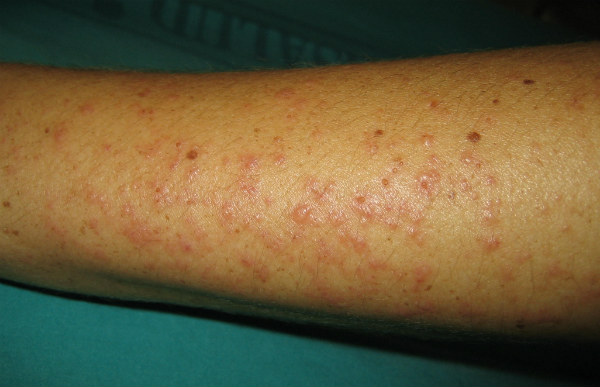The term “sun allergy”, from a medical point of view, is quite ambiguous, since there are many situations in which pimples or hives may appear on the skin after exposure to the sun. This may be due to different diseases or taking certain medicines. In any case, the most frequent form of “sun allergy” is technically called polymorphous light eruption, which is typical of the season we are in: spring and summer.

WHAT IS polymorphic light eruption?

These are skin lesions of different shape and appearance (hence the name “polymorphous rash”) usually located on the neckline, shoulders and back of the hands. It is rarer, but can also affect the legs. Characteristically, it appears in areas that are usually covered during the winter.
Polymorphous light eruption is the most common form of sun allergy, usually appearing in spring and improving as summer progresses.
Small pimples (most common), welts or even vesicles or small blisters may appear. Sometimes it resembles insect bites. It usually appears in spring or early summer, fading as the weeks go by and disappearing again at the end of summer. It often recurs year after year.
Images of polymorphic light eruption
¿HOW IS polymorphous light eruption DIAGNOSED?
The appearance and evolution of the pimples are often sufficient to make a diagnosis. In specific cases, a skin biopsy may be necessary to confirm the diagnosis.
PLE is the most common form of sun allergy; however, it is important to rule out other causes of sun allergy.
If pimples or other lesions appear after sun exposure, it is important to consult a dermatologist to confirm whether it is a polymorphous light eruption or other skin diseases that are also aggravated by the sun.
Is polymorphous light eruption HEREDITARY OR CONTAGIOUS?
It is thought that there is a certain genetic component in the appearance of polymorphous luminal rash, so that up to 45% of people who suffer from it have some history in the family.
Can polymorphic light eruption be prevented?
•SUN PROTECTION:

Obviously the most important measure to take is photoprotection. It is important to use physical measures (such as hats, T-shirts…) and protective creams for UVB as well as for UVA. All sunscreens in the European Union are required to protect against UVA at least 1/3 of what they protect against UVB; but from this minimum there are those that cover more and those that cover less. This is important, because both UVB and UVA (and even in some cases, visible light) can trigger the appearance of pimples.
•PHOTOTHERAPY:
Curiously, it seems that as exposure to the sun increases, the skin acquires a kind of tolerance to the sun. Somehow it seems to get used to it and as the summer progresses, the appearance of pimples becomes less likely. Therefore, in cases where photoprotection is not sufficient, their appearance can be prevented by phototherapy (UVA or UVB rays administered in a medical center). Phototherapy prepares the skin before sun exposure, so that when it arrives, the skin is already “prepared”.
Sun protection is the most important preventive measure. In some cases, it can be prevented with dermatologist-controlled phototherapy.
•VITAMINS AND OTHER ANTIOXIDANTS:
Vitamin supplements with antioxidants can be taken a few months before sun exposure, although their effectiveness is still controversial, since there are not enough scientific studies with clear conclusions to recommend their use in all cases.
HOW IS polymorphic light eruption TREATED?
In cases where you have not been able to prevent the appearance, the spots can be treated with a corticosteroid cream; with which the spots disappear within days (as long as you do not continue to expose yourself to the sun :). In more severe cases, it may be necessary to take corticosteroids in pill form.
HOW LONG does polymorphic light eruption last?
It is considered to be a chronic disease, so it is likely to appear year after year and relevant prevention and precaution must be maintained over time. But it is also true that over time (within years), in about half of the cases the symptoms tend to diminish or even disappear.
In conclusion…
The most common cause of sun allergy is polymorphous light eruption. This is not a serious disease but it tends to recur every year. To prevent it, sun protection (UVB and UVA) is essential, not only with sunscreen but also with hats, shirts,…. In some cases more specific treatment is needed, for which it is advisable to see a dermatologist.
